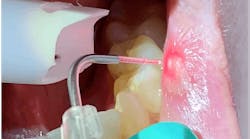New material used in molar extraction sites optimizes bone regeneration and dental implant stability
Journal of Oral Implantology – Dental surgery is a difficult, painful process no matter what the procedure, but having a tooth extracted and an implant put in months later can result in major complications. The longer you wait for the implant, the greater the likelihood that formation of scar tissue or shifting of teeth will occur to compensate for the loss of the extracted tooth; this can cause problems when it is time to insert the new implant.
Great advancements in dental surgery have been made to assist with bone and tissue regeneration so that when it is time to insert the implant, the extraction site has been stabilized and a graft performed to protect the integrity of the site. The article “Guided Bone Regeneration for Socket Preservation in Molar Extraction Sites: Histomorphometric and 3D Computerized Tomography Analysis” in the Journal of Oral Implantology introduces a new, more advanced method for this regeneration that prevents infection and maximizes bone regeneration.
The most commonly used treatment for post extraction regeneration has been a combination of acellular dermis matrix (ADM), a type of bone regenerating material that uses cadaveric tissue with all of the cells removed, and different grafting procedures. However, there has been no solid histologic data or microscopic tissue samples to prove that this regeneration is working properly.
This case series examines a new ADM replacement material called decellularized dermis matrix (DDM) that, combined with mineralized bone grafts called mineralized cancellous bone allograft (MCAB), guides the regeneration of bone to allow for a more stable placement of the implant. This method has a higher regeneration percentage and supports a more stable future implant site than previous therapies.
Tissue samples were examined both microscopically and using 3D imaging. Valuable surgery preparation time was saved using DDM, which can be stored fully hydrated, and the material was easy to handle and adapted well to the shape of extraction-site defects. A minimum of 12 weeks post extraction, the study found that none of the molar extractions had developed infections. A loss of bone volume was also prevented, allowing for optimal implant placement and stability. These results demonstrate the value of DDM and MCAB in preparing molar extraction sites to support implant placement.
Full text of the article, “Guided Bone Regeneration for Socket Preservation in Molar Extraction Sites: Histomorphometric and 3D Computerized Tomography Analysis,” Journal of Oral Implantology, Vol. 39, No. 4, 2013, is available here.
About Journal of Oral Implantology
The Journal of Oral Implantology is the official publication of the American Academy of Implant Dentistry. It is dedicated to providing valuable information to general dentists, oral surgeons, prosthodontists, periodontists, scientists, clinicians, laboratory owners and technicians, manufacturers, and educators. The JOI distinguishes itself as the first and oldest journal in the world devoted exclusively to implant dentistry. For more information about the journal or society, please visit: www.joionline.org






